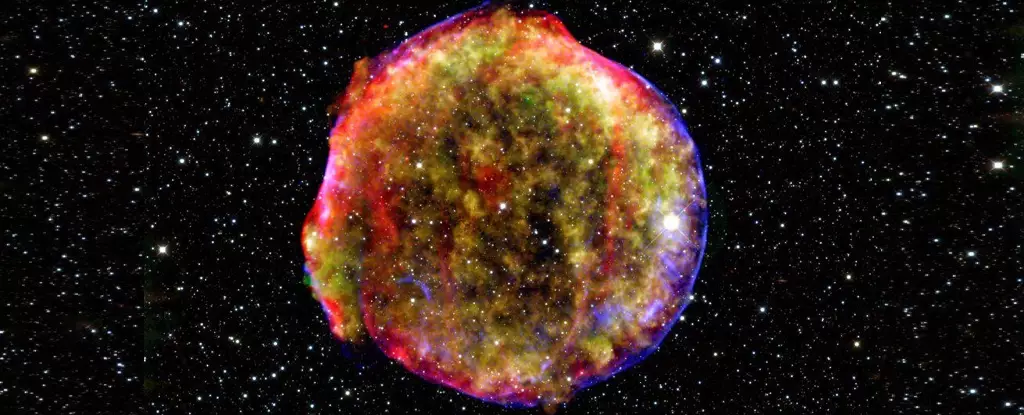In the vast expanse of our galaxy, a tapestry of cosmic phenomena weaves together a narrative of tantalizing secrets and astronomical intrigue. Among these mysteries lies the origin of cosmic rays—high-energy particles that bombard Earth and challenge our understanding of the universe. The prevailing theory has long pointed toward the explosive demise of stars, specifically supernovae, as a primary source for these ultra-energetic cosmic messengers. However, recent advancements in astrophysical research have sparked a critical reevaluation of this notion, as scientists grapple with the contradictions posed by existing data and theoretical models.
Astrophysicists have dedicated over a century to tracking the elusive paths of cosmic rays, akin to an amateur detective searching for the tidbits that lead back to a hidden origin. The journey is fraught with complexity, particularly due to the interference of cosmic magnetic fields that distort the trajectories of these charged particles. The challenge, then, is not merely to identify sources, but to decode the volatile dance of energies that govern the cosmos’ grand design.
Reviving the Supernova Theory
As central to this debate is the 1572 supernova known as Tycho’s star, an event that captivated astronomers for centuries. The collapse of a white dwarf sparked a thermonuclear explosion that cast a brilliant light against the backdrop of the night sky. Recent analyses of Tycho’s remnants have uncovered troubling discrepancies; while intuitive theories propose that supernovae should generate significant magnetic fields capable of accelerating cosmic rays, the latest studies have suggested those fields are “significantly smaller” than anticipated. This poses a serious challenge to the established narrative that dying stars can act as cosmic accelerators.
The implications are both exhilarating and concerning. Are we prepared to abandon our long-held beliefs about the cosmos? Or is this merely an incremental step towards a deeper insight? Some leading physicists, including Robert Brose and Iurii Sushch, are unwilling to relinquish the supernova hypothesis just yet. Instead, they advocate a reconsideration of the conditions necessary for particles to reach extreme acceleration levels, hinting that these celestial events may in fact possess hidden nuances yet to be discovered.
The Case for PeVatrons
At the forefront of this inquiry lies the exhilarating concept of PeVatrons—hypothetical cosmic engines capable of producing particles with energies reaching peta-electronvolt (PeV) levels. These behemoths of the universe remain largely mysterious, yet Brose, Sushch, and Jonathan Mackey suggest that dying stars could harbor the potential for PeVatrons to exist. However, their theory hinges upon the moment of a supernova and the subsequent dispersion of material that surrounds the dying stellar mass.
The timing of these cosmic fireworks is crucial; researchers propose that only a relatively young supernova, within its first decades, possesses an adequate density of surrounding material to create the necessary turbulence. A dramatic shock wave from the stellar explosion colliding with this dense environment could theoretically generate enough magnetic turmoil to send atomic nuclei and electrons spiraling into the realm of PeV energies. Such a phenomenon could revitalize our understanding of cosmic ray origins and invigorate the field of astrophysics with new questions and explorations.
What Lies Ahead?
The crux of the matter raises vital questions about temporal alignment and the transient nature of cosmic events. Had Tycho’s star lingered in its dying breaths a bit longer, we might have observed a cascade of cosmic rays that would further elucidate the PeVatron hypothesis. The tantalizing possibility remains that the next supernova in our cosmic vicinity may provide the definitive evidence needed to resolve the enigma once and for all.
As we peep out from the confines of our earthly existence into the limitless cosmos, it becomes evident that our understanding is still merely scratching the surface of celestial physics. The beauty and terror of our universe shine brightly, bound by forces we only partially comprehend. Scientists lean heavily on innovation and mathematical models, yet must remain humble in recognizing that the truths of the cosmos are wild and unpredictable. With each supernova, we are reminded not just of our fragile existence but also of the potential for discovery that lies in the working mechanisms of stars, shadowy beams of energy, and the inquisitive minds that dare to decode the great tapestry of the universe.


Leave a Reply